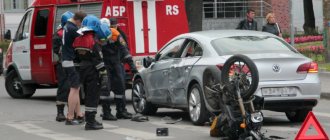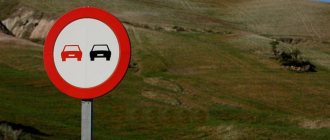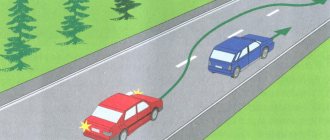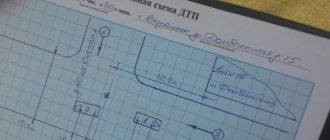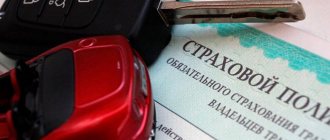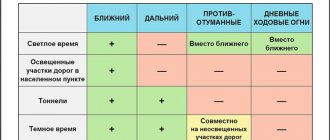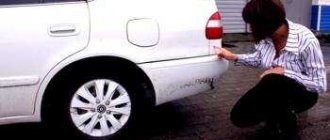If you hit a car from behind, who is to blame? A traffic accident is a very unpleasant event on the road. Usually there are two subjects of an accident - the culprit who caused the collision and the victim. Lawyer practice indicates that when a driver drives into the rear of a car, it is not always his fault.
Most often, during an accident, not all citizens understand the nuances of the event and always panic. In addition, they agree with the conclusions of the traffic police inspector when analyzing the accident and determining the culprit of the incident.
The article is intended to explain all the legal subtleties and specifics of this type of accident, to indicate what the possible reasons for its occurrence may be, and whether the driver who drove into the rear bumper is always at fault. After reading the material, the reader will know how to drive on the road and how to avoid trouble.
What does the traffic rules say if you overtake a car during an accident?
The accumulated experience of Russian auto lawyers involved in handling situations related to traffic violations indicates that you should not make hasty decisions (when a similar incident occurred) and immediately admit your guilt and pay off the damage caused.
To begin with, let's give a definition of traffic rules - this is a legal document designed to regulate not only the movement of vehicles, but to resolve all controversial issues that may arise in the event of a traffic accident between drivers.
For each specific case, this set of rules contains the appropriate formulation of what actions should be taken in a particular emergency situation.
In order to avoid colliding with the car ahead, you should adhere to the requirements and recommendations that are prescribed in the Rules.
Food for thought
Let us turn to section No. 9 “Location of vehicles on the roadway”, paragraph 9.10: “... the person driving the car must maintain such a safe distance in relation to the vehicle in front so that during emergency braking it is possible to avoid a collision with it. The same applies to the lateral interval.”
The essence of this postulate is that when you are driving on the road, the distance to the car in front should be such that if it starts to brake, the driver behind has the opportunity to slow down in time.
It is impossible to stop any vehicle by instantly pressing the pedal. This is achievable if it crashes into an obstacle (tree, wall). Therefore, maintaining a certain traffic distance when driving is the most important factor for safe driving, both in the city and outside it.
Clause 1 of Section 10 of the Rules says at what speed you can drive on the road, “... the vehicle must move in the mode that is established in this area, taking into account weather conditions, traffic congestion, technical condition of the vehicle, visibility and weight and character transported cargo."
The selected speed should provide the driver with the opportunity to constantly monitor the situation around him, so that if there is a risk of an accident, he can reduce it or stop driving, preventing a collision.
Expert commentary
Selivanov Alexander Andreevich
Lawyer, specialization civil law.
Ask a question
Therefore, when on a suburban highway or an intersection in the city one of the cars is driven into the rear and it is necessary to determine who is to blame, first of all, it is necessary to carefully study what happened, based on the norms prescribed in the Rules, taking into account all objective and subjective reasons.
About the distance according to traffic rules
So, the situation described above is actually quite common. Let's present it schematically, if it is suddenly unclear what we are talking about.
It remains to find out who is to blame. So, what is the distance according to traffic rules? This is the distance to the vehicle in front. The rules stipulate that it must be safe and do not provide specific values. But the main thing is that we have no need to know about the distance in the context of the car in front. This is because in paragraph 9.10 we are talking about a car moving in front, but not about a stationary one.
9.10. The driver must maintain such a distance from the vehicle in front that would allow him to avoid a collision, as well as the necessary lateral interval to ensure traffic safety.
Therefore, the distance in the case of driving too close to the car in front does not matter, since traffic rules require that it be observed only in relation to the vehicle moving in front.
In this case, is it true that the driver of the red car in the diagram above did not violate anything? Right. Did the driver of the blue car violate anything? I violated it and that's it.
Cases when the driver behind is not at fault
Engine accident, who is to blame? There are situations in life when, in a collision, a motorist who has driven into the rear bumper of a car will be found not guilty.
This can be influenced by several factors, but first of all, it is the actions of the driver driving ahead that must be taken into account.
Indicate in which case in an accident the driver behind the train is not to blame.
Situations can be identified:
- The car ahead suddenly stopped moving due to unforeseen circumstances (it hit an obstacle or another vehicle).
- The one who drove into the rear was hit first.
- Group clash.
Let us analyze each of the indicated cases in more detail so as not to make mistakes in practice. The first thing you should do is not to panic and evaluate everything soberly.
It’s good when there was a camera (video recorder) working in the cabin, which can clarify the investigation process and speed up the identification of the culprit.
Hitting a car in front
This is one of the most common situations, let's analyze it in detail. In accordance with clause 9.10 of the Russian Traffic Regulations, the driver must always maintain a safe distance so that in the event of sudden braking, an accident can be avoided.
What is this concept and how is it interpreted in specialized scientific literature and reference books?
This is the distance between cars moving along the road at approximately the same speed in one direction, which allows the driver moving behind to avoid a collision with another car in the event of a sudden stop.
When driving, everyone will use the standard braking system, which cannot (due to many factors) instantly stop the vehicle.
However, if the next foreign car or truck ahead crashes into an obstacle, fence, infrastructure structure, or another driver, then he instantly stops and cannot continue driving.
The car moving behind (the person driving it) sees a suddenly stopped vehicle in front of it, and because of the accident that has occurred, takes a maneuver or reduces speed to prevent a collision.
However, more often than not, the braking system cannot react every second and an impact occurs in the rear bumper. At the same time, the driver will not be found guilty, since he could not, for objective reasons, suddenly stop driving.
This fact indicates the absence of guilt and in most cases there will be no administrative liability.
The person who drove into the rear was first hit from behind
To understand this situation, it is necessary to consider it with a specific example.
Three cars were moving along the highway, in the same direction. The first of them, before performing the maneuver, slows down, the second, keeping a safe distance, presses the brake pedal, reducing speed to avoid an accident.
At that moment, the third participant unexpectedly crashed into the bumper of the “second driver” in his car. Due to the impact, his car is carried forward and he hits the first vehicle.
Analyzing this episode, we can state the following: there is one traffic accident, the culprit of which is the owner of the third car, as he did not keep his distance.
Since the second participant in the accident kept a safe distance in accordance with the traffic rules, he could not have crashed into the first one without being affected by the impact of the person responsible for the accident.
After all, it was he who provoked the clash. The third driver did not comply with the requirements of current regulations and caused an accident, which caused damage to two more cars.
If the driver was hit in the ass later
Not everything is interpreted unambiguously here, so we will consider this case based on existing legal practice.
The first driver slows down, and the second, not keeping a distance, crashes into him. The car following behind hits the one in front, since the vehicle in front of it suddenly stopped moving.
In fact, there is a group collision between three traffic participants. How to understand such an extraordinary and complex situation at first glance?
It is obvious that the second driver is at fault, since he did not comply with traffic rules - he did not take into account the safe distance to the car in front. The third driver could not stop in 1-2 seconds, since an accident occurred ahead and an unexpected obstacle arose.
Then, as a result, the guilt will be recognized with the second participant in the group clash.
However, the third party involved in the accident may also be guilty. The degree of his responsibility may arise from a number of factors that may influence the final decision.
Such circumstances include:
- what is the time interval between the first and second collision;
- was there a safe distance between the last two cars;
- weather conditions and speed of all participants are taken into account;
- whether the third motorist was distracted while driving;
- Are there any DVR recordings?
Carrying out all the necessary examinations at the scene of the incident will thoroughly answer any questions that arise after this type of accident occurs. Taking into account all subjective and objective factors, it is possible to accurately reconstruct the picture of the accident.
Who is to blame for a rear-end collision?
In rear-end accidents, in the vast majority of cases, the person behind is at fault, and rightfully so. However, very often the driver who was in front bears some of the blame. Sometimes it is enough to slightly adjust your driving style, and the likelihood of a rear-end collision will drop significantly.
Sudden braking
In the routine of daily travel, we rarely let the car in front go far enough to stop in any scenario. Most often, a completely safe distance is so great that someone else will simply wedge into the resulting “slot,” so most drivers choose a distance based on certain average scenarios.
Therefore, your task is to avoid sudden braking, which will take the rear ones by surprise. To do this, you need to calculate the situation several steps ahead and brake in advance and smoothly. If you are approaching a pedestrian crossing and see people, you don’t need to wait until the last minute and brake with a stake: rear drivers may interpret your behavior as an unwillingness to stop at all, so sharp braking will come as a surprise to them. It’s the same with intersections: there are many people who like to jump through them on yellow, giving in to the gas. But if you create the illusion that you will go through the intersection on yellow, sharp braking at the last moment can “solder” to you the same flyer who wanted to pass behind you.
Anticipatory braking
Experienced drivers brake progressively, observing the behavior of the car behind them. It doesn't hurt to simply touch the brake pedal first to turn on the brake lights and see if other drivers react to them. Naturally, you still have this privilege if you predict the situation and do not put off braking until the last moment.
The habit of turning on the brake lights proactively is generally useful. Let's say you're approaching a blind crosswalk and you're not sure if there are people in it. Touch the brake pedal to indicate that cars behind you can brake. If there are no people, you just move on without losing anything. There is no penalty for turning on unnecessary stops.
Shake off the inadequate
Very often, in the rear-view mirrors, an inadequate person is drawn, who embroiders in rows, wedges himself into the gaps, and presses against those in front. If one of these gets behind you, you need to be extremely careful, because the attention of the rider himself is usually concentrated on the effect that he, in his opinion, produces on everyone around him.
Sometimes it doesn't hurt to give him a lane, unless, of course, your driver's ego is against such concessions. Another way is to slow down without braking hard and force him to pass you as quickly as possible. In extreme cases, the above-mentioned warning activation of the brake lights without actual braking also helps. At a minimum, you can understand the degree of inadequacy of a person, and if he does not respond to “stops” at all, it is better to skip him at the first opportunity.
Less ambiguity
Many rear-end collisions occur due to misinterpretation of the actions of the person in front. For example, when turning left, you let oncoming cars pass, see a gap and move off, but at the last moment you get scared and suddenly brake. If the car behind hopes to pass in the same coupling with you, it will react to your starting from a stop as if it were a signal from the starting pistol.
Another scenario is common at exits from the “ears” of viaducts and on other roads that intersect at an acute angle. The driver behind is forced to look “over his shoulder” to where the flow is on the main road. If you start moving, it usually turns its attention completely to the cars driving on the road it crosses, and your sudden braking can play a cruel joke.
Wedge with wedge
A situation with a very controversial culpability: the driver changed lanes at a close interval between cars, which provoked a rear-end collision. Depending on the nuances, both the one behind (did not maintain the distance) and the one in front (did not provide an advantage) may be at fault. When changing lanes in heavy traffic, keep in mind that you often do not leave room for the rear driver to maneuver, especially if you combine a lane change with heavy braking.
Set your intentions
In addition to the brake lights themselves, drivers always react to indirect warning signs of braking. For example, if you are driving in the right lane and are about to turn, do not neglect to turn on your turn signal in advance: this will cause most drivers behind a natural desire to prepare to brake or try to get ahead of you in the next lane.
Teachers
The most popular way to “teach” a driver who has angered you in some way is to wedge in front of him and slam on the brakes. The logic is usually this: even if a collision occurs, the one behind will be to blame. However, the traffic rules contain clause 10.5, which prohibits the driver from sharply braking if this is not required to prevent an accident. Of course, the fact of sudden braking for no reason still needs to be proven, but with the proliferation of recorders, this has become easier.
If a collision is inevitable...
You are standing at a traffic light, and “it” is rushing behind you... Experienced drivers, by the way, are not lazy to monitor the situation in the mirrors regularly, even in static conditions: this is at the level of habit.
What to do if the driver behind you does not have time to stop? First, press yourself against the back of the seat and lean the back of your head against the headrest - this will reduce the risk of spinal injury. If there is free space in front, sometimes it is worth releasing the brake pedal or even moving away to reduce the intensity of the impact. There have been cases when drivers dodged a braking car, leaving its path in time, but this requires experience and luck.
But if you are pinned down and there are other cars or people ahead, most often you need to hold the car with the brake to reduce its “swing” forward. Let's say that in most cars the most expensive components are located in the front part: headlights, radiators, etc. Therefore, if we think pragmatically, an impact to the rear is generally “more profitable” than a simultaneous impact to the front.
Summary
Don’t trust drivers who have had five accidents in a year, all through no fault of their own. Even if the authorities recognized their correctness, the abundance of “no fault” accidents often indicates that a person’s driving style provokes accidents.
The main rule is to remain predictable. Whoever is “hanging” on your tail, most likely, he does not want to get into an accident - just like you yourself. Therefore, if you do everything smoothly, in advance and transparently, the likelihood of an accident will decrease many times.
Source: https://svpressa.ru/auto/article/120927/
When the car in front is at fault
Such accidents often happen on the roads. Often, a vehicle ahead or standing can provoke a serious accident, often with very serious consequences.
This may happen in the following cases:
- The driver was reversing and crashed into a moving car.
- An incorrect maneuver of the vehicle occurred (automatic set-up).
- The vehicle was in the wrong place on the highway and was poorly visible due to limited visibility by other road users.
In almost all of these cases, the vehicle in front will be at fault. However, we will consider each of these cases in more detail, referring to the current legislation regulating this type of offense.
The front one was moving backwards
The traffic rules specifically state that such a maneuver is classified as complex and requires professional driving skills and increased driver attentiveness.
Clause 8.12 of Section No. 8 of the Traffic Regulations indicates that driving in reverse, provided that the car does not interfere with other participants and does not affect their movement and maneuvering.
However, the Rules provide language when this is prohibited. You can't back up at intersections like that. In addition, such a maneuver cannot be done in places where turning is prohibited.
In accordance with clause 8.11 of the Traffic Regulations of the Russian Federation, this is prohibited:
- At pedestrian crossings.
- At intersections and bridges.
- In the tunnel and highway.
- At railway crossings and at stops.
- On overpasses and overpasses.
- Where visibility on the road is less than 100 meters.
Therefore, if the car was backing up and hit the car, the culprit will be the one who violated the traffic rules.
Note! When driving backwards, you need to control the situation, be extremely careful, move at a very low speed, and if necessary, turn on your hazard lights or honk.
Auto setup
This is not uncommon on modern Russian roads. Therefore, while driving you need to be extremely careful.
The best way out of trouble is to record the video recorder and call the traffic police. In such situations, there is always reason to suspect a criminal conspiracy among attackers, because there is more than one gang of scammers operating on the road.
In such situations, the main thing is not to get lost and not to give in to their persuasion. And if they start to “press”, you need to call the police and write a statement.
A typical case of an accident on the road is when the driver suddenly cuts off the car and exposes his rear. As a result, a collision occurs. Here the only salvation will be the video recorder and witnesses of the accident.
The vehicle was parked in the wrong place
This means when it is parked where it is prohibited to stop, as it interferes with other vehicles. These can be the sides of narrow roads, tram tracks.
For example, a heavy truck is in an area with limited visibility.
When such a collision occurs with a stationary vehicle, it is not uncommon to occur in an area with limited visibility. Often the driver does not see an obstacle in front of him at the last moment.
Therefore, the one who left his SUV or bus on the side of the road, which caused the emergency, will be found guilty.
In what cases is the driver of the car in front at fault?
There are 3 common situations in which when two cars collide, the one in front will be at fault.
The most popular place for such an accident, where the car behind crashes into the one in front, is considered to be an intersection or pedestrian crossing. A situation where a car decides to move into an adjacent area in order to turn off the main road is not uncommon.
This usually happens like this: the driver of the car in front suddenly brakes without seeing the red traffic light, or allows a pedestrian to pass. As a result, the motorist driving behind does not have time to react and crashes into the first car.
The second version of the accident, where there will be no fault behind the driving car: when the driver, being in front, tried to change lanes from one lane of the road to another, and the rear car drove into the bumper. This accident has two development options:
- The car driving in front abruptly changes lanes into the lane you are driving in and brakes sharply for various reasons (for example, a steering problem or the brakes are stuck).
- A car that is standing on the side of the road quickly enters your lane and you do not have time to brake. As a result, a collision is inevitable.
The third option for an accident, which is gaining popularity, is a “set-up” from the driver of the car in front.
The owners of such vehicles are trying to make money from people who are attracted to their maneuvers. They deliberately brake sharply or change lanes. In such cases, you can prove your innocence only with the help of a video recorder.
Is it possible that the rear driver is not to blame if the front driver brakes for no reason?
Emergency braking is one of the actions permitted by the Rules, designed to prevent a possible accident (Section 10.5 of the Traffic Regulations).
However, it is prohibited to brake suddenly or unintentionally on the road, as this may confuse or threaten the safety of other road users. In simple terms, you can only brake sharply in emergency cases.
In the situation under consideration, if the first driver braked without reason, he will be found guilty, provided that a violation on his part is proven.
The second participant in the accident, who drove into his bumper, will also be held administratively liable, as he did not maintain a safe distance while driving.
Therefore, when a driver crashes into the bumper of another car that applied emergency braking to prevent an accident, the culprit will be the second participant in the collision, who does not maintain the required distance.
In this case, the first driver must prove that an accident really could have happened and he sharply reduced speed or stopped.
Is it always the one who hits you from behind who is at fault?
Yandex provides about 700 thousand answers to this question. On numerous forums, lawyers, car enthusiasts and car experts are fighting in an attempt to find a universal solution or resolve a specific situation. Traffic police officers, as a rule, decide the issue of guilt this way and that, but most often they do not split the hairs and charge the driver driving behind with failure to maintain a safe distance and clause 10.1 of the traffic rules - a universal magic wand. In most cases, when analyzing such accidents, it is necessary to understand whether the drivers made (or made) any maneuvers at the time of the collision or immediately before it, and whether these maneuvers were safe for other road users? The legal qualifications of drivers’ actions depend on this.
The accident described here occurred in winter, in snowy conditions, immediately after the intersection on the descent. The driver of the Nissan car drove through an intersection, no more than 20 meters beyond which on the left was his house and the entrance to the garage, turned left and stood at an angle of about 20-30 degrees to the direction of the road, allowing an oncoming car to pass. From behind, the left rear of the Nissan car was hit with its right front part by a UAZ car, colloquially referred to as a “loaf”.
In this photo, behind the UAZ, you can see the section of the road where the collision occurred.
The questions that the court put for examination were standard - the speed of the loaf, the relative position of the cars at the time of the collision and whether the driver of the UAZ had the technical ability to avoid the Nissan.
The deformations of both cars were minor, the UAZ car in the accident diagram was not tied to anything along the length of the road, so the question of speed disappeared, and from the damage it is clear that its speed was low.
The UAZ driver explained that the Nissan blocked his way, braking downhill at an icy intersection, and even with fresh snow on top, did nothing, and the oncoming car did not allow him to pass the Nissan on the left. The traffic police, as usual, charged the driver of the UAZ with clause 10.1 of the traffic rules, guided by the principle “the one who hit from behind is to blame.”
When going to court, the Nissan driver and his representative did not even imagine that everything would turn out the other way around, and the court would find the Nissan driver guilty. Everything was so “obvious”.
During the examination, questions about the relative position of the cars at the time of the collision and whether the UAZ driver had the technical ability to avoid the Nissan were resolved by simply comparing the cars and making a large-scale diagram. It turned out that the distance between the right rear corner of the Nissan and the edge of the road was indeed less than the width of the UAZ. On the right, behind the snow bank, there is a pedestrian path, on the left, there is an oncoming car, and the decision to ram the Nissan was the only correct one.
The representative of the UAZ owner in court used “Typical diagrams of road traffic accidents and the distribution of responsibility of participants in a road traffic accident for the harm they caused when preparing documents for road traffic accidents without the participation of authorized police officers,” which, although not for legal purposes, place, but were developed by the Research Center for Road Safety Problems of the Ministry of Internal Affairs of the Russian Federation (SRC Road Safety Ministry of Internal Affairs of the Russian Federation).
This document can be found on the Internet. It follows from it that in such a situation the driver who violated clause 8.5 of the traffic rules is to blame: “Before turning right, left or making a U-turn, the driver is obliged to take the appropriate extreme position in advance on the roadway intended for traffic in this direction.”
The court decision and expert opinion are attached. For lawyers, an article by the author is also attached, with the help of which you can quickly estimate the magnitude of the loss or increase in speed by the impacted cars. The material in the article is presented in a simplified manner, but it is very useful for a quick assessment of the situation.
Why are speeds needed? And to check whether there was an excess, or to check the safety of the maneuver.
Perhaps, as usual, some of the lawyers will express displeasure that the expert is again trying to impose unusual knowledge on lawyers. As usual, I answer that there is no such thing as too much knowledge. And if it’s difficult on your own, you’ll always find a smart tenth grader to do the calculations using the formulas in the article. 
What to do if found guilty
This often happens on Russian roads. Police officers may take a careless and one-sided approach to the performance of their official duties and, without fully understanding it, impose a fine for failure to maintain a distance on a driver who has driven into the rear bumper of a moving car in front. Not all citizens understand what to do in this case.
It is necessary to explain in as much detail as possible everything that happened, provide facts and testimony of witnesses.
A DVR recording will undoubtedly help clarify the situation. If the data contained in the protocol does not correspond to reality, you can make notes when signing it, referring to the lack of proof of guilt.
When this does not work and the inspector has issued a decision to impose administrative liability or issued a receipt for payment of a fine, you must write a complaint to the city or district court within 10 days to challenge this decision.
The court, having begun proceedings, will usually resolve the disputed case. If you are aware of incompetent performance of your functional duties by traffic police officers, you can complain to the Internal Affairs Directorate of the Ministry of Internal Affairs of the Russian Federation or submit an application to the Prosecutor's Office.
When can a fine not be imposed?
A fine cannot be issued by the traffic police if there was no accident or additional markings where the distance between cars is visible, recorded in the photo, which in itself is very difficult for one person to accomplish in a short period of time.
In case of an accident, a fine for failure to maintain a distance is not issued if one of the cars is parked and not in motion.
Important!!! A fine for not keeping the distance is issued only if 2 cars are in motion!
Example of non-compliance with distance
Let's say you are driving behind a car that suddenly decided to brake, without warning signs that it was about to make a maneuver. There is no photo or video recording. You don't have time to react and crash into the car in front. If there are no witnesses, you will be the culprit, since you did not calculate the distance for safe driving in case of emergency braking of the car in front.
Although, even in such cases, witnesses and even video footage may not save you. It all depends on the integrity of the traffic police, who are ready to understand the situation and the second driver, who is ready to talk.
Important!!! In this situation, the car behind is always found guilty if there is no evidence of the guilt of the first one.
